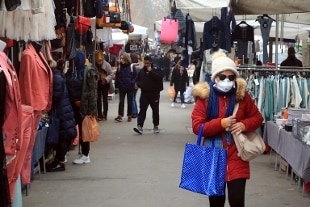- Fontana: "You can't give up, especially in Milan. Change of course maybe Thursday"
- Coronavirus, here is the "Cura Italia" decree. The planned measures
- Veneto, Zaia: carpet pads
Share
March 17, 2020 "Atmospheric particulate matter, in addition to being a carrier, that is, a transport and diffusion vector for many chemical and biological contaminants, including viruses, constitutes a substrate that can allow the virus to remain in the air in conditions vital for a certain time, in the order of hours or days. " To say it is a group of researchers of the Italian Society of Environmental Medicine (SIMA) who, in collaboration with the Universities of Bari and Bologna, have examined the data published on the sites of the ARPA (the regional agencies for environmental protection) related to all detection units active on the national territory, recording the number of episodes of exceeding the legal limits (50 microg / m3 of average daily concentration) in the Italian provinces.In parallel, they analyzed the cases of contagion from COVID-19 reported on the Civil Protection website, coming to the conclusion that "there is a relationship between the exceedances of the legal limits of PM10 concentrations recorded in the period from 10 to 29 February and the number of COVID-19 infected cases updated to March 3 ".
The concentrations in the Po Valley
In the Po Valley, the researchers said in particular, the infection expansion curves were observed "which showed anomalous accelerations, evidently coinciding, 2 weeks apart, with the highest concentrations of atmospheric particulate matter, which exercised a boost action, that is, an impulse to the virulent spread of the epidemic ". The effect, according to researcher Leonardo Setti of the University of Bologna, is most evident "in those provinces where there were the first outbreaks".
To echo him Gianluigi de Gennaro, of the University of Bari: "Dusts are carrying the virus. They act as carriers. The more they are, the more highways are created for the infections. Minimize emissions and hope for a favorable meteorology" . So the impact of man on the environment "is producing health effects at all levels, adds Alessandro Miani, president of SIMA", according to which "this tough test that we are facing globally must be a warning for a future rebirth in truly sustainable key, for the good of humanity and the planet ".
Finally concludes Grazia Perrone, professor of chemical analysis methods of the Statale di Milano: "The position paper is the result of a non-profit study that brings together researchers and experts from different Italian research groups and is addressed in particular to decision makers ".
Cnr: "Growth rate drop expected in 3 days"
Meanwhile, the data are continuing to be analyzed to assess a possible slowdown of the infections. "Today we are five days after the introduction of the 'I stay at home' decree", and as reported in a report by the Istituto Superiore di Sanità the average value of time between the onset of symptoms and the diagnosis is 2-4 days , so if, as we believe, the introduction of restrictive measures on mobility are effective for reducing the risk of contagion, we expect to see a significant reduction in the growth rate in about three days. "This is the conclusion to which it is A study by the National Research Council's Institute for Calculation Applications (Cnr-Iac) has arrived on a forecast of the spread of Coronavirus, carried out with mathematical models that use the data provided by the Civil Protection, updated yesterday March 16.
"As far as Lombardy is concerned - the researchers explain - the small reduction in the growth rate of the fraction of the infected people observed for 12-13 March, 13-14 March and March 14-15. We hope the trend will continue in the coming days ". Evidence of the reduction in the growth rate "is also noted in the blockade of regions not bordering on Lombardy in central Italy: Tuscany, Umbria, Marche, Lazio and Abruzzo. Here too the previous considerations on the average value of time between infection and diagnosis apply" .
"For the southern regions, excluding Basilicata and Molise, where the numbers are still small, an increase in the growth rate after a previous decrease is observed - the note continues - This increase unfortunately occurred 3-4 days after the exodus from North to South on March 8, the day of approval of the decree establishing the red zone in Lombardy ". According to the researchers "probably, the effects of the exodus negatively affected the infection".
"For the southern regions, excluding Basilicata and Molise, where the numbers are still small, an increase in the growth rate after a previous decrease is observed - the note continues - This increase unfortunately occurred 3-4 days after the exodus from North to South on March 8, the day of approval of the decree establishing the red zone in Lombardy ". According to the researchers "probably, the effects of the exodus negatively affected the infection".
The data used, it is explained, are the official ones made available by the Civil Protection and the adopted strategy foresees the study of the phenomenon of spread of the contagion through different types of mathematical and statistical models and methods.
"Stabilization of the fraction infected between 25 March and 15 April"
Finally, "analyzing the data available so far according to the first approach, it is estimated that the stabilization of the fraction of the infected people will take place between 25 March and 15 April. These estimates - it is highlighted - are subject to great uncertainty due to various factors involved and must be continuously recalibrated according to the available data and changes in individual behavior ".

